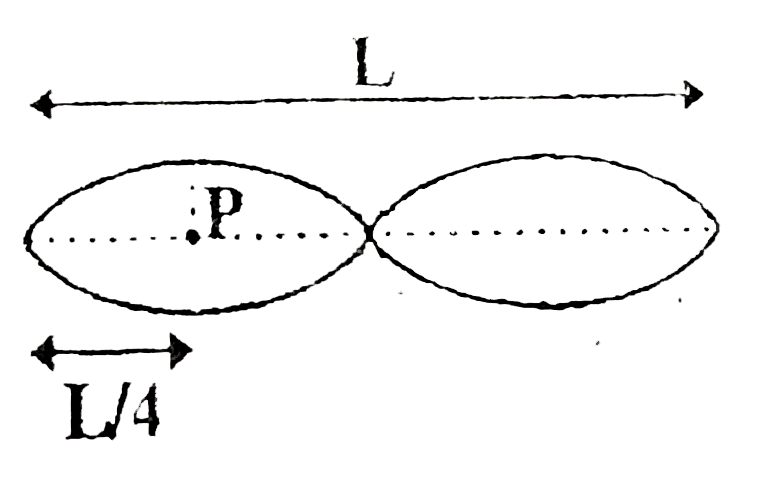A string vibrates in 5 segments to a frequency of 480 Hz. The frequency that will cause it to vibrate in 2 segments will be
(a) 96 Hz
(b) 192 Hz
(c) 1200 Hz
(d) 2400 Hz
The correct Answer is:B
To solve the problem, we need to find the frequency that causes the string to vibrate in 2 segments, given that it vibrates in 5 segments at a frequency of 480 Hz.
1. Identify the Harmonics:
- The string vibrating in 5 segments corresponds to the 5th harmonic (f5).
- The frequency given for the 5th harmonic is 480 Hz.
2. Relate Harmonics to Fundamental Frequency:
- The relationship between the harmonics and the fundamental frequency (f0) can be expressed as:
- fn=n⋅f0
- For the 5th harmonic:
- f5=5⋅f0
- Therefore, we can write:
- 480Hz=5⋅f0
3. Calculate the Fundamental Frequency (f0):
- Rearranging the equation gives:
- f0=480Hz5=96Hz
4. Find the Frequency for 2 Segments (f2):
- The frequency for the 2nd harmonic (f2) is given by:
- f2=2⋅f0
- Substituting the value of f0 we found:
- f2=2⋅96Hz=192Hz
5. Conclusion:
- The frequency that will cause the string to vibrate in 2 segments is 192 Hz.
Final Answer:
The frequency that will cause the string to vibrate in 2 segments is 192 Hz.
---
- The string vibrating in 5 segments corresponds to the 5th harmonic (f5).
- The frequency given for the 5th harmonic is 480 Hz.
- The relationship between the harmonics and the fundamental frequency (f0) can be expressed as:
- fn=n⋅f0
- For the 5th harmonic:
- f5=5⋅f0
- Therefore, we can write:
- 480Hz=5⋅f0
- Rearranging the equation gives:
- f0=480Hz5=96Hz
- The frequency for the 2nd harmonic (f2) is given by:
- f2=2⋅f0
- Substituting the value of f0 we found:
- f2=2⋅96Hz=192Hz
- The frequency that will cause the string to vibrate in 2 segments is 192 Hz.
The frequency that will cause the string to vibrate in 2 segments is 192 Hz.
Topper's Solved these Questions
- BOOK - DC PANDEY ENGLISHCHAPTER - SUPERPOSITION OF WAVESEXERCISE - Level 2 More Than One Correct6videos
SUPERPOSITION OF WAVES
- BOOK - DC PANDEY ENGLISHCHAPTER - SUPERPOSITION OF WAVESEXERCISE - More than One correct Options1videos
SUPERPOSITION OF WAVES
- BOOK - DC PANDEY ENGLISHCHAPTER - SUPERPOSITION OF WAVESEXERCISE - Subjective Questions6videos
SUPERPOSITION OF WAVES
- BOOK - DC PANDEY ENGLISHCHAPTER - SOUND WAVESEXERCISE - Exercise 19.74videos
SOUND WAVES
- BOOK - DC PANDEY ENGLISHCHAPTER - THERMOMETRY THERMAL EXPANSION AND KINETIC THEORY OF GASESEXERCISE - Medical entrance gallary30videos
THERMOMETRY THERMAL EXPANSION AND KINETIC THEORY OF GASES
Similar Questions
A string vibrates in 4 segments to a frequency of 400 Hz.
(a) What is its fundamental frequency?
(b) What frequency will cause it to vibrate into 7 segments?View SolutionA string fixed at both ends is vibrating in the lowest mode of vibration for which a point at quarter of its length from one end is a point of maximum vibration . The note emitted has a frequency of 100Hz. What will be the frequency emitted when it vibrates in the next mode such that this point is again a point of maximum vibratin ?
View Solution
Knowledge Check
- Question 1 - Select One
A string of length 2 m is fixed at both ends. If this string vibrates in its fourth normal mode with a frequency of 500 Hz, then the waves would travel on its with a velocity of
A125 ms−1B250 ms−1C500 ms−1D1000 ms−1
A string vibrates in its first normal mode with a frequency of 220 vibrations /s. The vibrating segment is 70.0 cm long and has a mass of 1.20g.
(a) Find the tension in the string.
(b) Determine the frequency of vibration when the string vibrates in three segments.View SolutionA string vibrates with a frequency 200Hz. Its length is doubled and its tension is altered until it begin to vibrate with frequency 300Hz. What is the ratio of the new tension to the original tension?
View SolutionA string vibrates with a natural frequency of 256 Hz. Which of the tuning fork given below will resonate with the string ? (i) A of frequency 512 Hz, (ii) B of frequency 256 Hz, and (iii) C of frequency 128 Hz. Give reason.
View SolutionA 1 cm long string vibrates with fundamental frequency of 256 Hz . If the length is reduced to 14 cm keeping the tension unaltered, the new fundamental frequency will be
View SolutionA uniform string is vibrating with a fundamental frequency 'f'. The new frequency, if radius & length both are doubled would be
View SolutionA 12 m long vibrating string has the speed of wave 48 m/s . To what frequency it will increase .
View SolutionA string fixed at both ends is vibrating such that a point at quarter of its length from one end is a point of maximum displacement. The frequency of vibration in this mode is 100Hz. If the frequency emitted when it vibrates in the next mode such that this point is again a point of maximum displacement is 100k then find the value of k.
 View Solution
View Solution

